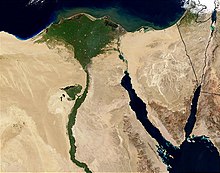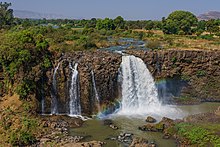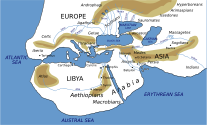Nile
[12] After Khartoum the river flows north, almost entirely through the Nubian Desert, to Cairo and its large delta, joining the Mediterranean Sea at Alexandria.'the mouths of the front parts'), which referred specifically to the branches of the Nile transversing the Delta, and would have been pronounced ni-lo-he in the area around Memphis in the 8th century BCE.[20] Another derivation of Nile might be related to the term Nil (Sanskrit: नील, romanized: nila; Egyptian Arabic: نيلة),[15] which refers to Indigofera tinctoria, one of the original sources of indigo dye.[24] With a total length of about 6,650 km (4,130 mi)[a] between the region of Lake Victoria and the Mediterranean Sea, the Nile is among the longest rivers on Earth.[27] The Nile basin is complex, and because of this, the discharge at any given point along the main stem depends on many factors including weather, diversions, evaporation and evapotranspiration, and groundwater flow.[32][31] In addition, in 2010, an exploration party in Rwanda[33] went to a place described as the source of the Rukarara tributary,[34] and by hacking a path up steep jungle-choked mountain slopes in the Nyungwe Forest found (in the dry season) an appreciable incoming surface flow for many kilometres upstream, and found a new source, giving the Nile a length of 6,758 km (4,199 mi).For the remaining part, it flows westerly through the Murchison Falls until it reaches the northern shores of Lake Albert where it forms a significant river delta.The tectonic uplift of the Nubian Swell diverts the river south-west for over 300 km, following the structure of the Central African Shear Zone embracing the Bayuda Desert.At Al Dabbah it resumes its northward course towards the first cataract at Aswan forming the S-shaped Great Bend of the Nile[38] mentioned by Eratosthenes.During the dry season the natural discharge of the Blue Nile can be as low as 113 m3/s (4,000 cu ft/s), although upstream dams regulate the flow of the river.During the wet season, the peak flow of the Blue Nile often exceeds 5,663 m3/s (200,000 cu ft/s) in late August (a difference of a factor of 50).The wadi passes through Gharb Darfur near the northern border with Chad and meets up with the Nile near the southern point of the Great Bend.[59] At some point the sediments raised the riverbed sufficiently for the river to overflow westward into a depression to create Lake Moeris.Thus, all tombs were west of the Nile, because the Egyptians believed that in order to enter the afterlife, they had to be buried on the side that symbolized death.Akhet, which means inundation, was the time of the year when the Nile flooded, leaving several layers of fertile soil behind, aiding in agricultural growth.[66] To the ancient Greeks and Romans, the upper reaches of the White Nile remained largely unknown, as they failed to penetrate the Sudd wetlands of South Sudan.Agatharchides records that in the time of Ptolemy II Philadelphus, a military expedition had penetrated far enough along the course of the Blue Nile to determine that the summer floods were caused by heavy seasonal rainstorms in the Ethiopian Highlands, but no European of antiquity is known to have reached Lake Tana.It was published in full only in the early 20th century, but was featured in works of Páez's contemporaries, like Baltazar Téllez,[74] Athanasius Kircher[75] and Johann Michael Vansleb.For example, Pliny the Elder writes that the Nile had its origins "in a mountain of lower Mauretania", flowed above ground for "many days" distance, then went underground, reappeared as a large lake in the territories of the Masaesyli, then sank again below the desert to flow underground "for a distance of 20 days' journey till it reaches the nearest Ethiopians."[78] Modern exploration of the Nile basin began with the conquest of the northern and central Sudan by the Ottoman viceroy of Egypt, Muhammad Ali, and his sons from 1821 onward.Three expeditions under a Turkish officer, Selim Bimbashi, were made between 1839 and 1842, and two got to the point about 30 kilometres (20 miles) beyond the present port of Juba, where the country rises and rapids make navigation very difficult.Believing he had found the source of the Nile on seeing this "vast expanse of open water" for the first time, Speke named the lake after Queen Victoria.A quarrel ensued which sparked intense debate within the scientific community and interest by other explorers keen to either confirm or refute Speke's discovery.While most Egyptians still live in the Nile valley, the 1970 completion of the Aswan Dam ended the summer floods and their renewal of the fertile soil, fundamentally changing farming practices.The Sudd also forms a formidable navigation obstacle and impedes water flow, to the extent that Sudan had once attempted to build the Jonglei Canal to bypass the swamp.Each computer run postulated a set of reservoirs and operating equations for the release of water as a function of the month and the levels upstream.Despite the development of many reservoirs, drought during the 1980s led to widespread starvation in Ethiopia and Sudan, but Egypt was nourished by water impounded in Lake Nasser.The dispute between Egypt and Ethiopia over the $4.5 billion Grand Ethiopian Renaissance Dam has become a national preoccupation in both countries, stoking patriotism, deep-seated fears and even murmurs of war.The expedition began at the White Nile's beginning at Lake Victoria in Uganda, on 17 January 2004 and arrived at the Mediterranean in Rosetta, four and a half months later.On 29 January 2005, Canadian Les Jickling and New Zealander Mark Tanner completed the first human-powered transit of Ethiopia's Blue Nile.


















Nile (disambiguation)KhartoumWhite NileBlue NileLake TanaNile DeltaAtbaraAfricaMediterranean Sealongest river in the worldAmazon Riverdrainage basinDemocratic Republic of the CongoTanzaniaBurundiRwandaUgandaEthiopiaEritreaSouth SudantributariesheadwatersconfluenceGreat LakesLake Victoriarivers meetNubian Desertlarge deltaAlexandriaEgyptian civilizationSudanese kingdomsAswan DamAncient EgyptRhônewater dischargeArabicEgyptian languageCopticSahidicBohairicNobiinLugandaRunyoroEgyptian ArabicStandard ArabicBiblical HebrewAncient GreekMemphisHesiodTheogonyPotamoiOceanusTethysSanskritromanizedIndigofera tinctoriaindigo dyeNymphaea caeruleaTutankhamunSemiticOld LibyanCongo Riverdischargemain stemevaporationevapotranspirationgroundwaterLake NoEast African RiftSource of the Nile (board game)Source of the Nile BridgeGish AbayEthiopian HighlandsKagera RiverRuvyironza RiverRurubu RiverRukararaNyungwe Forestdry seasonRipon FallsJinja, UgandaLake KyogaMasindi PortKaruma FallsMurchison FallsLake AlbertNimuleAchwa RiverBahr al GhazalNile floodsanabranchBahr el ZerafMongallatranspirationSobat RiverMalakalsix groups of cataractsSabalokaAbu HamadNubian SwellCentral African Shear ZoneBayuda DesertAl DabbahEratosthenesLake NasserRosettaDamiettasuspended sedimentbedloadBeni SweifAtbarah RiverBlue Nile FallsBahir DarAmharicrainy seasonPompeiiOuaddaï highlandsWadi HowarGharb DarfurOikoumeneHerodotusStone AgeGulf of Sidramost recent ice agecapturedSahara